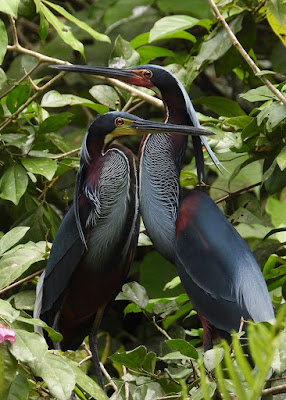We are about a week into our month-long filming trip and heading north to the Caribbean coast. The route will take us over the volcanic Talamanca mountains, over the Cerro de la Muerte (Hill of Death!), past the still active Turrialba Volcano into Cartago and then west past Limon to Matina.
At Matina we catch a pre-arranged boat for a 25 minute journey along well vegetated (and crocodile infested) waters to the Pacuare Reserve and Ecology Project situated in beautiful unspoilt jungle next to the Caribbean Sea. Upon arriving at the dock, we are met by a team of people pulling a large wooden cart and I was immediately struck that the whole scenario was not unlike a scene from LOST.
We transferred all of the baggage and equipment to the cart and walked the 300 meters to the station. The accommodation was rustic but comfortable. There's no electricity in the rooms but we are provided with solar bulbs, which we can charge during the day and run for about 12 hours. They have a laboratory another 250 meters along a track where we can charge our camera batteries and a communal dining room. I have to say, all of the people working here were incredibly friendly and we soon felt right at home. The reason for visiting Pacaure was to film the largest (and most accessible) breeding colony of Agami Herons in the Americas and they also have nesting Leatherbacks, including a hatchery on the beach.
 |
| The reserve layout |
 |
The accommodation, complete with
colourful murals |
 |
| Pacaure beach and the Caribbean Sea |
 |
The Caribbean Sea isn't the expected blue colour
here but a churning sandy brown. |
 |
Young Leatherbacks from a hatching nest
are gathered together for safe release |
 |
| A couple of baby Leatherbacks making a bee-line for the sea |
The next morning we head straight to the Agami colony and spend a couple of hours with them. I count 49 birds, mostly paired up but there are many more as the viewing area only shows a small sector of their breeding trees. They are a truly incredible site - a bird I have dreamed of seeing since learning we were coming here earlier this year. I'm not to be disappointed...
 |
Agami's are like no other heron I've ever seen.
They're the most elegant and beautiful birds. |
 |
Their facial skin can change colour in a
matter of seconds. The bird with the red face
(a female)changed to yellow a few minutes later. |
 |
And this is the red faced individual above as it starts
to turn yellow like its mate. It can flush back to red just as quickly |
 |
Agami on alert, we never saw a single bird
hunting while we were present. Apparently some birds
fall foul of the local Caiman so they possibly hunt elsewhere. |
 |
| Young male White-necked Jacobin |
We also saw plenty of reptiles and amphibians at Pacuare too.
 |
| Striped Basilisk Basilicus vittatus, male - shedding its skin |
 |
Central American Whiptail Holcosus festivus
These were very common along the path sides |
 |
| Green Basilisk Basiliscus plumifrons |
 |
| The endemic and very pretty Red-eyed Tree Frog Agalychnis callidryas |
 |
| Red-eyed Tree Frog Agalychnis callidryas |
 |
| Olive Long-snouted Tree Frog Scinax elaeochroa |
 |
| White-lipped Mud Turtle |
 |
| White-lipped Mud Turtle |
 |
White-lipped Mud Turtle with it's
distinctive plastron |
 |
| Fresh Jaguar pug mark |
And good numbers of primates were seen as well. Howler monkeys aren't always easy to view as they sit high in the canopy but this small family group crossed the camp along the roof tops very close to us.
 |
| Howler Monkey, mother and young |
 |
| Howler Monkey, male with his large vocal sac. |
Our stay at Pacuare finally over, we set off for Rancho Naturalista. Renowned for it's hummingbirds I was looking forward to seeing another long-time dream bird...the Snowcap!

























No comments:
Post a Comment